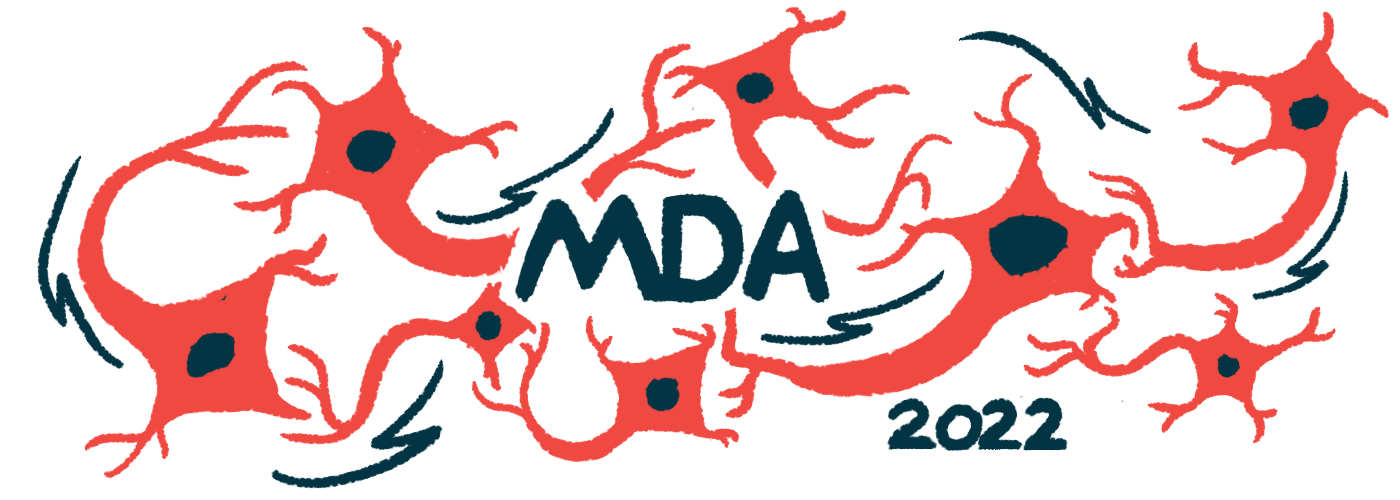#MDA2022 – CNM-Au8 May Slow Progression, Reduce Risk of Death

Treatment with Clene Nanomedicine’s experimental medicine CNM-Au8 may decrease the risk of disease progression or death in people with early amyotrophic lateral sclerosis (ALS), according to new analyses from the RESCUE-ALS clinical trial.
Data also suggest that the therapy helped to prevent the loss of motor neurons in ALS patients — marking the first time that any potential ALS treatment has shown clinical evidence of doing so, according to Clene researchers.
“We are showing evidence of improved survival, a significant slowing in disease progression, … significant slowing of functional decline, … significant improvement in quality of life, and preservation of lower motor neurons,” Robert Glanzman, MD, Clene’s chief medical officer, said during a presentation at this year’s Muscular Dystrophy Association (MDA) Annual Meeting.
Glanzman’s talk was titled “Phase 2 Results RESCUE-ALS: Randomized, Double-blind, Placebo-Controlled Study in Early Symptomatic Amyotrophic Lateral Sclerosis Patients on Stable Background Therapy to Assess Bioenergetic Catalysis with CNM-AU8 to Slow Disease Progression in ALS.” The study was funded by Fight MND Australia.
First evidence of a therapy preserving motor neurons
CNM-Au8 contains a suspension of gold nanocrystals that are designed to help brain cells boost their energy reserves and increase their resistance to stress. The RESCUE-ALS trial (NCT04098406), completed in 2021, enrolled 45 people with early-onset ALS, who were randomly selected to take 30 mg of CNM-Au8, or a placebo, daily for 36 weeks, or about nine months.
The trial participants represented “a pretty typical early ALS population,” Glanzman said — there were slightly more men than women, and about three-quarters of the participants had limb-onset disease, where initial symptoms affect the arms and legs. The other quarter had bulbar-onset disease, in which initial symptoms affect the face and throat.
The study’s main goal was to test whether the treatment could prevent the loss of motor neurons — nerve cells controlling movement that are lost in ALS — as measured by Motor Unit Number Index (MUNIX) scores. RESCUE-ALS was the first known study that used MUNIX as a primary measure of efficacy.
“This is a very novel study. It’s the first time that an electrophysiological measure like MUNIX has been used as a biomarker for proof-of-concept in ALS,” Glanzman said.
Top-line study results, announced late last year, showed that the treatment overall failed to significantly alter MUNIX scores compared with a placebo. The use of CNM-Au8 also did not significantly affect measures of lung function in the top-line results.
But those early results did not accurately reflect the real impact of the therapy, the researchers now say.
Notably, the nerves that were assessed to calculate MUNIX scores in the study all are controlled by the spinal cord. Typically, patients with limb-onset ALS have more spinal cord damage, whereas those with bulbar-onset disease have relatively normal spinal cords, Glanzman said.
Consistent with that, further analyses showed that, among patients with bulbar-onset ALS, MUNIX scores did not change much over the course of the trial, even in participants given a placebo. This probably contributed to the lack of statistical significance in the results, according to Glanzman.
Now, Glanzman said, further examination has shown that, among the participants with limb-onset ALS, MUNIX scores decreased by about 40% in the placebo group and a little over 20% in the CNM-Au8-treated patients.
The findings mean that the active treatment was able to slow the loss of motor neurons by about 45% over the 36 weeks.
“To our knowledge, this is the first time that any therapy has been shown to preserve motor neurons in ALS patients based on estimated electrophysiological” measures, Glanzman said.
Slowing decline, improving life quality, and extending survival
Other analyses showed that treatment with CNM-Au8 significantly slowed the rate of decline on the ALS Functional Rating Scale Revised (ALSFRS-R), a standardized measure of disease severity.
After 36 weeks, about 80% of patients on the placebo had experienced a decline in ALSFRS-R scores of six points or more. By comparison, less than 60% of patients given CNM-Au8 experienced such a severe decline over the study’s course. Similar differences were seen in patients with both limb- and bulbar-onset ALS.
Treatment with CNM-Au8 also significantly improved quality of life compared with a placebo.
“CNM-Au8 had a remarkable improvement in quality of life, highly statistically significant. This is likely because the drug appears to be effective, and it’s very easy to take,” Glanzman said. He described taking the therapy as feeling mostly like drinking a small amount of water, since CNM-Au8 is about 99% water, but still contains a hundred trillion gold nanocrystals.
In other analyses, the researchers calculated the risk of ALS disease progression, which they defined as the occurrence of death, tracheostomy — a tube inserted into the neck to help a patient breathe — non-invasive ventilatory support, or gastrostomy (feeding) tube placement.
Results showed that, over the 36-week trial, CNM-Au8 significantly reduced the risk of ALS disease progression, by about 37%, as reported in the trial’s abstract. This effect was seen in both bulbar- and limb-onset patients.
Of the participants in RESCUE-ALS, 80% entered into a long-term open-label extension study, wherein all were treated with the investigational therapy.
In a separate poster at the MDA conference, titled “Evidence for an ALS Survival Benefit with CNM-AU8 Treatment: Interim Results from the RESCUE-ALS Trial Long-term Open Label Extension,” a team led by scientists at Clene conducted analyses to calculate the experimental treatment’s effect on survival.
Using data from the European Network for the Cure of ALS (ENCALS), the researchers constructed statistical models of expected mortality, and compared these models against what was actually observed in the study. Results suggested that treatment with CNM-Au8 reduced the risk of mortality significantly, by approximately 57%.
“These results demonstrate improved survival with CNM-Au8 treatment compared to estimated median survival derived from the ENCALS prediction model,” the researchers concluded in the study’s abstract.
Safety data for CNM-Au8 have been “remarkable,” Glanzman said. To date, no serious adverse events (side effects) or drug-related treatment discontinuations have been reported. The most common adverse events deemed potentially linked to treatment are aspiration pneumonia, nausea, and abdominal discomfort.
CNM-Au8, as well as several other potential ALS therapies, are currently being tested in the HEALEY ALS Platform Trial (NCT04297683), the results of which are expected later this year.
“We look forward to the continued advancement of the ALS clinical program with the top-line results from the HEALEY ALS Platform Trial expected in the second half of the year,” Glanzman said in a press release.
“The preclinical and clinical data presented at MDA further support Clene’s lead drug candidate CNM-Au8 as a potential disease-modifying therapy for amyotrophic lateral sclerosis,” he added.








